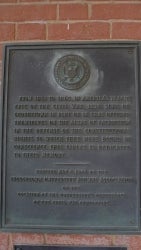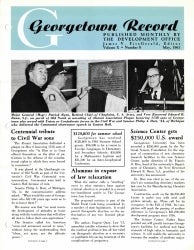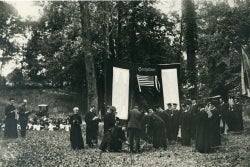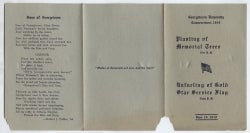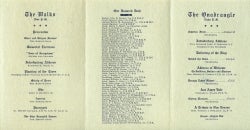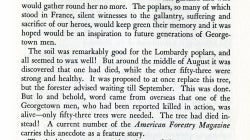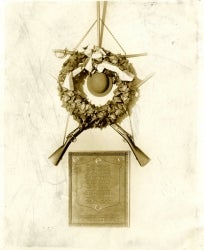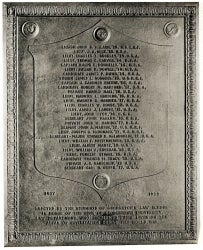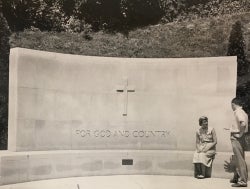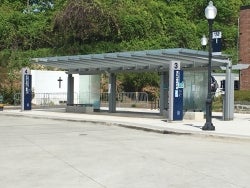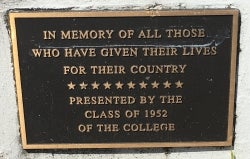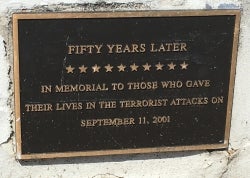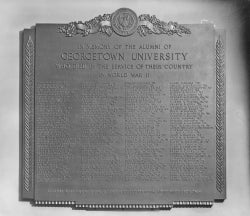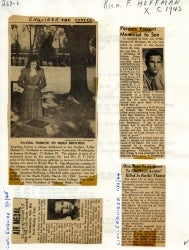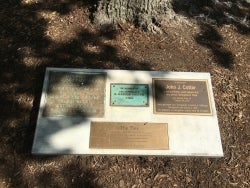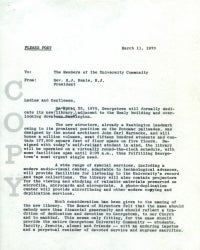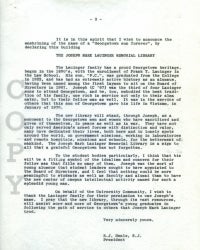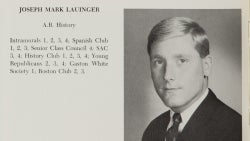There have been a number of war memorials placed on Georgetown’s campus but some may be unknown even to people long familiar with our buildings and grounds. Some of these memorials are no longer extant; others are located in low trafficked locations or carry no notice to explain their memorial role. This exhibit seeks to highlight these memorials through documents and photographs from the Georgetown University Archives.
The first war memorials on campus were created after World War I, in honor of students who died in that war. These were followed in the late 1940s and early 1950s by memorials to students who died serving in World War II. The one hundredth anniversary of the beginning of the Civil War saw the unveiling of a plaque on the porch of Old North to students who had fought on both sides of that conflict. And the era of the Vietnam War brought another, more universal memorial - Lauinger Library, named for one alumnus who died in Vietnam and dedicated, according to the naming announcement, to Georgetown men and women who have sacrificed and given of themselves, in peace as well as in war.
Civil War plaque on the Old North Building. Photograph by LuLen Walker
The Civil War memorial plaque on the porch of the Old North Building to the Sons of Georgetown in Blue or in Gray [who] offered themselves on the altar of patriotism was unveiled in 1961 as part of events on campus marking the 100th anniversary of the Civil War. This plaque was commissioned by the Alumni Association.
Since the formation of the President's Working Group on Slavery, Memory and Reconciliation in 2015, the University has been considering ways of memorializing the enslaved people who labored on campus or on the Jesuit plantations in Maryland and those whose sale in 1838 financially benefited the University. In 2017, a campus building was renamed for Isaac Hawkins, the first enslaved person mentioned in the 1838 sale agreement.
“Centennial tribute to Civil War sons.” Georgetown Record, May 1961
May 6, 1961 was selected as the date for campus ceremonies to mark the 100th anniversary of the Civil War. One hundred years earlier, in May 1861, the Sixty-Ninth Regiment of the New York State Militia, known as the “Irish Regiment” and numbering around fourteen hundred soldiers, was billeted in campus for a period of about three weeks and representatives of the 69th came to campus for the ceremonies. In addition to the plaque unveiling, a commemorative ceremony was held in Gaston Hall at which Senator Philip A. Hart, C‘1934, spoke, and a memorial mass was offered in Dahlgren Chapel.
World War I memorial tree planting, June 16, 1919
As part of the June 1919 commencement ceremony, members of the senior class planted 54 Lombardy poplar trees around the area Cooper Field occupies today to symbolize the 54 Georgetown students reported to the University as having been killed in action.
Program from Planting of Memorial Trees and Unfurling of Gold Star Service Flag ceremonies, June 16, 1919
Mention of the World War I memorial trees in "Miniatures of Georgetown, 1634 to 1934: Tercentennial Causeries" by Coleman Nevils, S.J.
In this section of Miniatures, Georgetown President W. Coleman Nevils, S.J. relates how one of the 54 trees died by mid-August 1919 and how, before it could be replaced, the University learned that the count of alumni dead was incorrect, that 53 rather than 54 alumni had died in war service, and that as a result only 53 trees were needed.
In 1927, for the University’s Memorial Day celebration that year, the trees were moved to the north end of the varsity athletic field (the area behind what is now White-Gravenor) at the request of the University President, Charles w. Lyons, S.J., who wanted them to be more visible. By 1938, according to reporting in the January 12 issue of The Hoya, 45 of them were still alive in that location.
World War I memorial plaque in the Law library
In 1924, an additional, more conventional memorial in the form of a bronze plaque was placed in the Law Library, then located at 506 E Street, N.W. This plaque was a gift of the Law Class of 1921. It bore the names of students from the school who had died fighting in World War I. A wreath was laid at this plaque as part of the Law School’s Memorial Day exercises into the 1950s. The plaque’s present location is unknown.
World War II memorial on the west side of McDonough Arena. Photographs by William Beanland, ca. 1952, and Lynn Conway, 2021
A gift of the College Class of 1952, this memorial is constructed out of marble. However, all the images of it in the University Archives show it painted white. A note on the back of one of the images explains that the memorial was Disfigured Permanently By Mt. St. Mary’s Students - Had To Be Painted.
World War II memorial on the west side of McDonough Gym: Original plaque and later 9/11 plaque. Photographs by Lynn Conway, 2021
World War II memorial plaque in the Georgetown University Hospital. Pictured in Ye Domesday Booke, 1949
This bronze plaque In Memory of the Alumni of Georgetown University Who died in the service of their country in World War II was placed outside the chapel in the (new) Georgetown University Hospital which opened on Reservoir Road in 1947.
World War II memorial benches and stone terrace outside Copley Hall. Clippings from the Cincinnati Enquirer, 1944 and 1945
Stone benches and a stone terrace below a red maple tree at the south end of Copley Hall were dedicated in 1945 to the memory of Richard Hoffman and all Georgetown heroes of World War II. A brass plaque, still visible, was laid into the terrace. The red maple was known to students between the 1930s and the 1960s as simply “the Tree.” It was a place, initially reserved for seniors, where they arranged to meet up with friends or simply congregated after meals and during breaks between classes.
Richard Hoffman, a Staff Sergeant in the U.S. Air Force, died when his plane was shot down over the Pacific in 1944. His parents donated the memorial, noting in their donation letter that Dick was very much interested in the social part of school activities and we may believe that in spirit at least, he will still be taking part in “bull” sessions around the old tree.
World War II Hoffman memorial plaque and plaques related to "The Tree" outside Copley Hall. Photograph by Lynn Conway, 2021
“The Tree” was struck by lightning in 1963 and had to be cut down. John J. Cotter (C'1946, L'1949) later donated money for a new tree to be planted in its place in honor of his father.
Announcement of the naming of Lauinger Library for Joseph M. Lauinger, 1970
Georgetown President R.J. Henle, S.J. announced on March 11, 1970, that the new University library would be named for Joseph M. Lauinger, C’1967, who was killed in Vietnam on January 8, 1970. President Henle noted in his announcement that the new library will stand, through Joseph, as a monument to the Georgetown men and women who have sacrificed and given of themselves, in peace as well as in war. They have not only served America's armed forces with distinction and valor, many have dedicated their lives, both here and in lonely spots around the world, on government missions, working in laboratories and remote hospitals, missions and schools, for the betterment of mankind. The Joseph Mark Lauinger Memorial Library is a sign to all that a grateful Georgetown has not forgotten.
Joseph Mark Lauinger. Pictured in Ye Domesday Booke, 1967
Ground was broken on the new library in June 1967 but the building remained without an official name until March 10, 1970, when Georgetown announced it would bear the name of Joseph Mark Lauinger, C’1967, who had been killed in Vietnam two months earlier at the age of 24. An army first Lieutenant, he was hit by enemy fire while commanding an Army unit on a reconnaissance mission.
The Lauinger family has a long and storied connection to the University, reaching back to the 1890s when Frank T. Lauinger enrolled in the Law School. His son, P.C., graduated from the College in 1922 and played an active role as an alumnus. In 1967 he became one of the first laymen appointed to the Board of Directors. Four of P.C.’s sons, including Joseph, attended Georgetown and family members have continued to graduate from the University.
Curated by Lynn Conway, University Archivist

